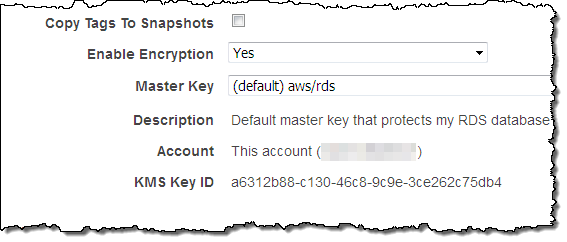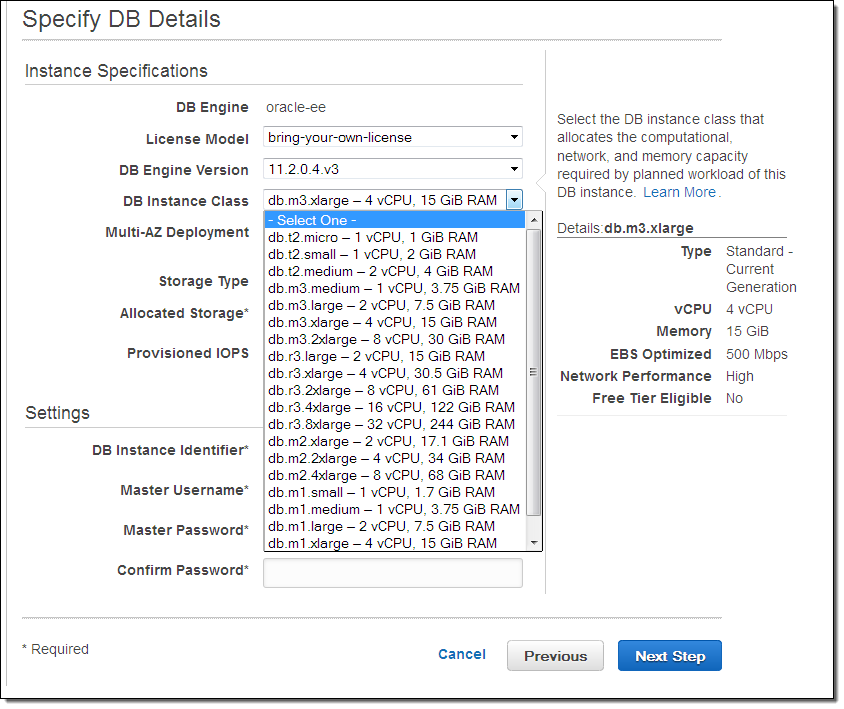AWS News Blog
Amazon RDS Update – Oracle + Brazil + Larger Volumes + More
|
|
I love to demo Amazon Relational Database Service (RDS) to live audiences! They always appreciate the fact that I can launch a MySQL, Oracle, SQL Server, PostgreSQL, or Amazon Aurora database instance with a couple of clicks.
Today I would like to bring you up to date on a bunch of improvements that we have recently made to the service. I was not able to blog about these at launch time so this might not be news, but I did want to make sure that you didn’t miss anything important. Here’s a quick summary of what I want to share with you:
- The t2.large database instance type is now available.
- Support for Oracle 12.1.0.2 and the latest patches is now available.
- R3 and T2 database instances can now run Oracle.
- The R3 database instances are now available in Brazil.
- Database instances running MySQL, Oracle, SQL Server, and PostgreSQL can now be provisioned with even more storage (4 – 6 TB, depending on the database engine).
- Tags on database instances are now copied to snapshots, and from there to instances restored from the snapshots.
- You now have access to a license-included offering for SQL Server Enterprise Edition.
Availability of t2.large Database Instances
The T2 instances provide you with a baseline level of CPU performance and the ability to burst above the baseline. They are designed for workloads that do not need the entire CPU on a full or consistent basis, and are priced lower than comparable M3 DB instances.
In addition to the existing instance types (db.t2.micro, db.t2.small, and db.t2.medium), you can now run all supported database engines on the new db.t2.large instance type. This instance type offers twice as much memory and 50% more CPU credits per hour than the db.t2.medium. It is available in the US East (N. Virginia), US West (N. California), US West (Oregon), South America (São Paulo), Europe (Ireland), Europe (Frankfurt), Asia Pacific (Tokyo), Asia Pacific (Sydney), Asia Pacific (Singapore), and China (Beijing) regions.
The t2.large also supports encryption at rest. You can set this up on the Configure Advanced Settings page:

Support for Oracle 12.1.0.2
RDS for Oracle now supports version 12.1.0.2 of Oracle datatabase 12c. You can use the new In-Memory option to store a subset of your data in an in-memory column format that is optimized for performance. This is a great fit for the newly available R3 databases instances described in the next section.
As part of this update, we also applied the April 2015 Oracle Patch Set Updates (PSU) for Oracle Database 11g and 12c and enabled access to the DBMS_REPAIR package. We also improved the integration with AWS CloudHSM; you can now access a single CloudHSM partition from multiple RDS accounts and you can store TDE master keys for multiple RDS Oracle databases on a single CloudHSM partition.
You now have access to the following versions of Oracle through RDS:
- 11.2.0.4.v4
- 12.1.0.2.v1
- 12.1.0.1.v2
Oracle on R3 and T2 Database Instances
The R3 instances are optimized for memory-intensive applications and have the lower cost per GiB of RAM of any DB instance. The instances deliver high sustained memory bandwidth and offer lower network latency, all at prices that are up to 28% lower than comparable M2 DB instances.
You can now run Oracle Database on the R3 and T2 instances:

R3 in Brazil
The R3 database instances are now available in the South America (São Paulo) Region, and can be used with the MySQL, Oracle, SQL Server, and PostgreSQL database engines.
Provision Even More Storage
Earlier this year we increased the amount of storage that you can provision when you use Provisioned IOPS or General Purpose (SSD) storage for an RDS database instance. Here are the new limits:
- MySQL, PostgreSQL, and Oracle database instances can now be provisioned with up to 6 TB of storage.
- SQL Server database instances can now be provisioned with up to 4 TB of storage and up to 20,000 IOPS (double the former limit).
Instance Tags to Snapshots, and Back
If you add tags to your database instances, create snapshots of those instances, and then use the snapshots to create fresh instances, the tags now appear on the new instances.
SQL Server Enterprise, License Included
You can now run SQL Server Enterprise Edition as a License Included offering on RDS. In other words, you do not need to purchase a separate license for the product; the pricing includes the software license, the underlying hardware resources, and the RDS management capabilities.
Available Now
These options are available now (some of them have been around for a month or two) and you can start using them today!
— Jeff;
